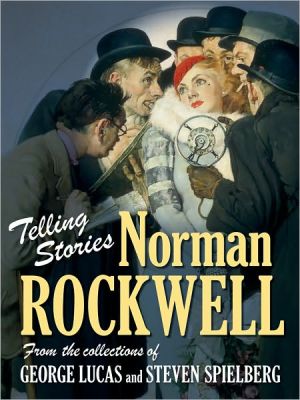Telling Stories: Norman Rockwell from the Collections of George Lucas and Steven Spielberg
Telling Stories, based on the Rockwell collections of George Lucas and Steven Spielberg, is the first book to chart the connections between Rockwell’s iconic depictions of American life and the movies. Rockwell, the quintessential American mythmaker of the 20th century, was a storyteller on a par with the great Hollywood directors of his time, and touched the lives of the two most successful directors of our day. Within Rockwell’s art, the fantasies and foibles of ordinary people are given...
Search in google:
Telling Stories, based on the Rockwell collections of George Lucas and Steven Spielberg, is the first book to chart the connections between Rockwell’s iconic depictions of American life and the movies. Rockwell, the quintessential American mythmaker of the 20th century, was a storyteller on a par with the great Hollywood directors of his time, and touched the lives of the two most successful directors of our day. Within Rockwell’s art, the fantasies and foibles of ordinary people are given life, central among them the themes of love of country, the sanctity of family, and the value of personal honor. Telling Stories, which accompanies an exhibition at the Smithsonian American Art Museum, is richly illustrated with Rockwell images, photographs, and film stills. Publishers WeeklyNorman Rockwell (1894-1978) is renowned for his Saturday Evening Post covers, but less known for his influence on filmmakers George Lucas and Steven Spielberg, who have extensive collections of his work. Accompanying an exhibition of their collections at the Smithsonian (opening this month), the catalogue frames Rockwell as a mythmaking storyteller who approached his subjects cinematically and revealed universal truths through the American vernacular. Smithsonian curator Mecklenburg provides an informative and crisply composed narrative of Rockwell's professional and personal life, re-evaluating conventional interpretations of both. Rockwell, she argues, "may have led a simple life, but was not a simple man," and his carefully constructed images reflected the need to juggle a number of sometimes competing factors: shifting editorial policies and the need to stay current while delivering images with universal appeal. Her text, richly complemented by scores of illustrations and photographs, traces the artist's evolution from an illustrator for children's magazines to a beloved artist. Of great appeal to the general reader interested in Rockwell or the intersection of art and film narrative. 118 color and 25 b&w illus. (July)
\ Publishers WeeklyNorman Rockwell (1894-1978) is renowned for his Saturday Evening Post covers, but less known for his influence on filmmakers George Lucas and Steven Spielberg, who have extensive collections of his work. Accompanying an exhibition of their collections at the Smithsonian (opening this month), the catalogue frames Rockwell as a mythmaking storyteller who approached his subjects cinematically and revealed universal truths through the American vernacular. Smithsonian curator Mecklenburg provides an informative and crisply composed narrative of Rockwell's professional and personal life, re-evaluating conventional interpretations of both. Rockwell, she argues, "may have led a simple life, but was not a simple man," and his carefully constructed images reflected the need to juggle a number of sometimes competing factors: shifting editorial policies and the need to stay current while delivering images with universal appeal. Her text, richly complemented by scores of illustrations and photographs, traces the artist's evolution from an illustrator for children's magazines to a beloved artist. Of great appeal to the general reader interested in Rockwell or the intersection of art and film narrative. 118 color and 25 b&w illus. (July)\ \ \ \ \ Library JournalNorman Rockwell (1894–1978) had close ties to Hollywood. His sojourn there in the 1930s taught him how to condense an entire story into a single image. This book, published in conjunction with a 2010 exhibition at the Smithsonian American Art Museum in Washington, DC, explores Rockwell's relationship to film as seen in his art and as part of the personal art collections of film directors George Lucas and Steven Spielberg (the impetus for the exhibition came from Spielberg). The book's many illustrations show Rockwell's work in colorful detail, but its essays give it depth. Mecklenburg (senior curator, Smithsonian American Art Museum) explores Rockwell's artistic career and his storytelling methods, while McCarthy (chief film critic, Variety) looks at Rockwell's "camera eye"—his ability to distill a story into its essence, revealed in a single illustration. The book also includes a list of illustrations. VERDICT Given Rockwell's continuing popularity, this fresh look at his work and working methods would be a wise purchase. Recommended for all libraries and Rockwell-loving patrons.—Martha Smith, Elmira Coll. Lib., NY\ \








